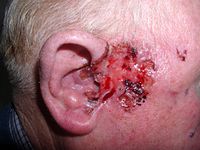
Photo from wikipedia
Background & Objective: Oral squamous cell carcinoma (OSCC) affects over 400,000 individuals globally, every year. When diagnosed early, the 5-year survival rate for OSCC is 64%, but two-third of these… Click to show full abstract
Background & Objective: Oral squamous cell carcinoma (OSCC) affects over 400,000 individuals globally, every year. When diagnosed early, the 5-year survival rate for OSCC is 64%, but two-third of these lesions are diagnosed in later stages, leading to lower survival rates (<40%). Clinical diagnosis of these lesions is complicated by benign and Oral-Potentially-Malignant-Disorders (OPMD) like oral lichenoid conditions (OLC), mimicking OSCC in clinical presentation. Studies in literature demonstrate high rates of incorrect chair-side diagnosis for OSCC and OPMD, making their early and accurate detection challenging. This clinical gap prompts a strong need for clinical chair-side point-of-care (POC) platforms, to aid accurate screening of these lesions and prevent diagnostic delays. Methods: In this work we present a ‘smart diagnostic approach’ that combines three key capabilities into an integrated sensing modality as follows: i) powerful microfluidic engine that allows for cytology measurements to be completed outside of a sophisticated lab infrastructure, ii) cytomics platform that allows for single cell molecular imaging to be completed in a portable analyzer, iii) AI-linked diagnostic models for early disease detection using cyto-signatures. This platform has been clinically validated across a multi-site prospective clinical study. Results: Multiple parameters including cellular phenotypes, nuclear parameters, biomarker expressions were indexed. Further, combining these features allowed discrimination and stratification of these lesions with high accuracy (99.3%) and significance. Further examination using logistic regression and receiver operating characteristic curve analyses yielded significant lesion identifiers and AUC values towards positive discrimination of OLC and OSCC (0.824 and 0.95, respectively vs benign lesions), with high sensitivity and specificity. Conclusion: This rapid (<30 minutes) cytopathology POC solution has the potential to impact OSCC and OPMD screening accurately, characterizing subtle cellular changes to aid long-term monitoring of these lesions. Additionally, this platform has the capability to uncover new parameters that can further aid these assessments and improve confidence in clinicians’ decisions. Citation Format: Kritika Srinivasan Rajsri, Michael P. McRae, Glennon W. Simmons, Alexander Ross Kerr, Nadarajah Vigneswaran, Spencer W. Redding, Malvin Janal, Stella Kang, Leena Paloma, Nicolaos J. Christodoulides, John T. McDevitt. A smart cytopathology risk-assessment platform for oral potentially malignant disorders and oral squamous cell carcinoma at the point-of-care [abstract]. In: Proceedings of the American Association for Cancer Research Annual Meeting 2023; Part 1 (Regular and Invited Abstracts); 2023 Apr 14-19; Orlando, FL. Philadelphia (PA): AACR; Cancer Res 2023;83(7_Suppl):Abstract nr 785.
Journal Title: Cancer Research
Year Published: 2023
Link to full text (if available)
Share on Social Media: Sign Up to like & get
recommendations!